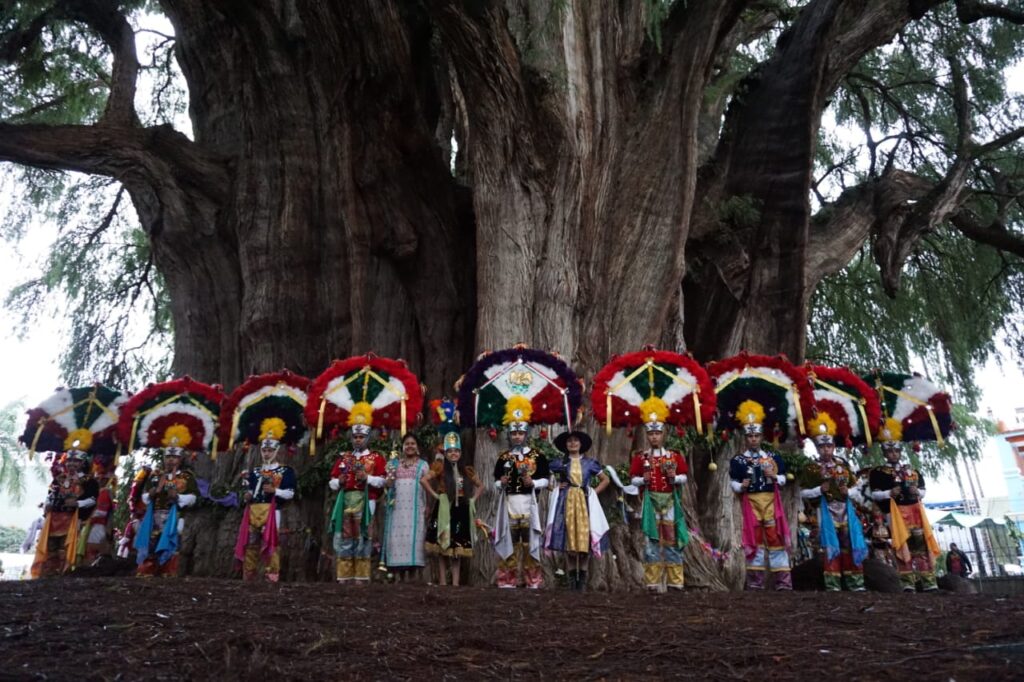
Table of Contents
Introduction
The El Arbol del Tule in Oaxaca, Mexico is certainly a sight to behold. The awe inspiring tree stands out with its gnarled trunk and is a fascination for many who visit. It is both an impressive and beautiful sight. This article gives an overview on the history, biology and the beauty of the El Arbol del Tule, for anyone wishing to explore further.
Thought to be as old as the nearby Mitla archaeological ruins, the Tule Tree is a Santa María del Tule landmark. Pose for photos alongside its massive trunk and search for the likenesses of everything from elephants and pineapples to lions and former Mexican presidents in the knots of its rugged bark.
Most organized visits to the Tule Tree—whether shared or private—are combined with stops at Mitla and Hierve el Agua, although some excursions also include visits to Teotitlán del Valle and local mezcal factories too. Visiting independently is also possible, although there’s little else to do in the town of Santa María del Tule itself.

Discover the Awe of El Arbol del Tule in Oaxaca
El Arbol del Tule, or The Tree of Tule, is located in Oaxaca, Mexico. It is a giant Montezuma cypress tree with an impressive circumference of 58 meters. It is believed to be the widest tree in the world and is a national monument in Mexico. It is estimated that the tree is at least 2000 years old and was thought to have been formed over a span of ten generations! Locals refer to this tree as “Gran Abuelo”, or Grandfather, probably because of its age and impressive size.
Explore the History Behind El Arbol del Tule
The origin and history of El Arbol del Tule is still uncertain and a matter of debate among researchers. What is known is that the tree draws its name from Tule, the town where it contentiously grows and has flourished. According to locals, this tree was believed to have been a meeting place for the Zapotec people who inhabited the region before the Spanish arrived in the 1500s. Furthermore, the tree has also drawn thousands of tourists from all over the world and was a site of national pride for Mexico.
Learn About the Biology of El Arbol del Tule
Humans planted this massive tree during the epoch. The locals spoke Nahuatl dialect before being colonized by Spaniards and referred to the tree as ahuehuete, which means “old man of the water,” in their dialect.
Even during the pre-Hispanic period, the tree’s name reflected its age. This shows why it’s among the oldest trees in the world.
El Tule’s age is estimated at between 600-1500 years old. But most scientists indicate that the tree is about 2,000 years old.
A local Zapotec legend believes that El Tule was planted by an Aztec priest, pechocha, 2000 years ago. Pechocha lived with a wind god called Ehacatl. The legend’s estimation is similar to the scientific analysis.
The Zapotecs coined El Tule’s name from their Nahuatl local language, meaning bulrush plant. The plant is a reed growing in marshes and swampy areas.
The species of the El Arbol del Tule is commonly known as the Montezuma cypress, also referred to as Taxodium mucronatum. It is native to tropical regions of Central and South America, thriving in wet and lowlands. One of its features that makes the El Arbol del Tule unique is its size and age, a result of optimal climate, soil and care given by locals over the years. Additionally, its thick and long roots spread out from the trunk like tentacles, allowing it to take nutrients from the soil and stabilizing it, contributing to its impressive size.
Witness the Wonders of El Arbol del Tule
The El Arbol del Tule presents several wonders that can be seen upon visiting. Firstly, there is the size, which is remarkable and one of the reasons it enjoys so much attention. Additionally, its gnarled trunk and huge branches are a reminder of the time it has spent growing over the years. Furthermore, the amazing peeling and vibrant bark of El Arbol del Tule is a marvel to behold. Lastly, its lush foliage and spindly cones give the tree a unique beauty.
Locals consider El Tule a tree of life representing Mexicans’ timeless and universal sacred traditions. El Arbol del Tule has been revered across many cultures and religions in Mexico for thousands of years.
You can join the pilgrims visiting El Tule and witness the oldest and stout tree that baffles even scientists. You have a chance to see a human’s eternal affinity.
It is not an exaggeration to say that El Arbol del Tule is the world’s last living link to ancient times.
The roots and trunk of El Tule remain complex. The process is explained through a children’s traditional event. The kids engage in an activity to find animal visages inside the wooden convolutions. Hence the name “Tree of life.”
Beliefs around El Tule are universal across many cultures, and the tree continues to represent the pre-Hispanic history populating Oaxaca.
There are fears that El Arbol del Tule is dying. However, nobody has come out clearly to reveal the unmistakable signs of the dying process.
However, there is an assertion that industrialization is the leading cause. But local leaders dispute the idea as they believe it’s a common belief that has been going on for years. But the tree has continued to survive and will likely be standing when many of us will all be gone.
Admire the Ancient Beauty of El Arbol del Tule
Besides being a significant symbol of Mexican heritage, El Arbol del Tule is an exceptional beauty to behold. From standing and viewing it from a distance, to exploring its twists, turns and details up close, El Arbol del Tule is certainly a sight to behold.
- Make sure to take protective measures and to stay inside the fence surrounding the El Arbol del Tule.
- Take the time to observe the different views of the tree from the surrounding areas.
- Expect to take lots of photographs! The El Arbol del Tule was made to be photographed!
How to Visit El Tule
El Arbol is within Church grounds in the town square. It is at the center of Santa Maria del Tule town, about seven miles from Oaxaca.
You can use the Mitla road, an important archeological site in Oaxaca. You pay a small fee of less than $1 to access El Tule. After receiving the entrance ticket, you will be given a leaflet expanding on some information about the tree.
When you visit El Arbol del Tule, be ready for overwhelming sensations. It is a unique life experience of joy and serenity. It offers the visitors a chance to attune to the ancient pre-historic feeling of pain and serenity.
Conclusion
El Arbol del Tule is a remarkable tree that brings awe and wonderment to everyone who sees it. With its impressive size, fascinating history and vivid beauty, El Arbol del Tule is definitely worth visiting. It is a symbol of pride and heritage for Mexico, and its beauty will definitely be memorable!

